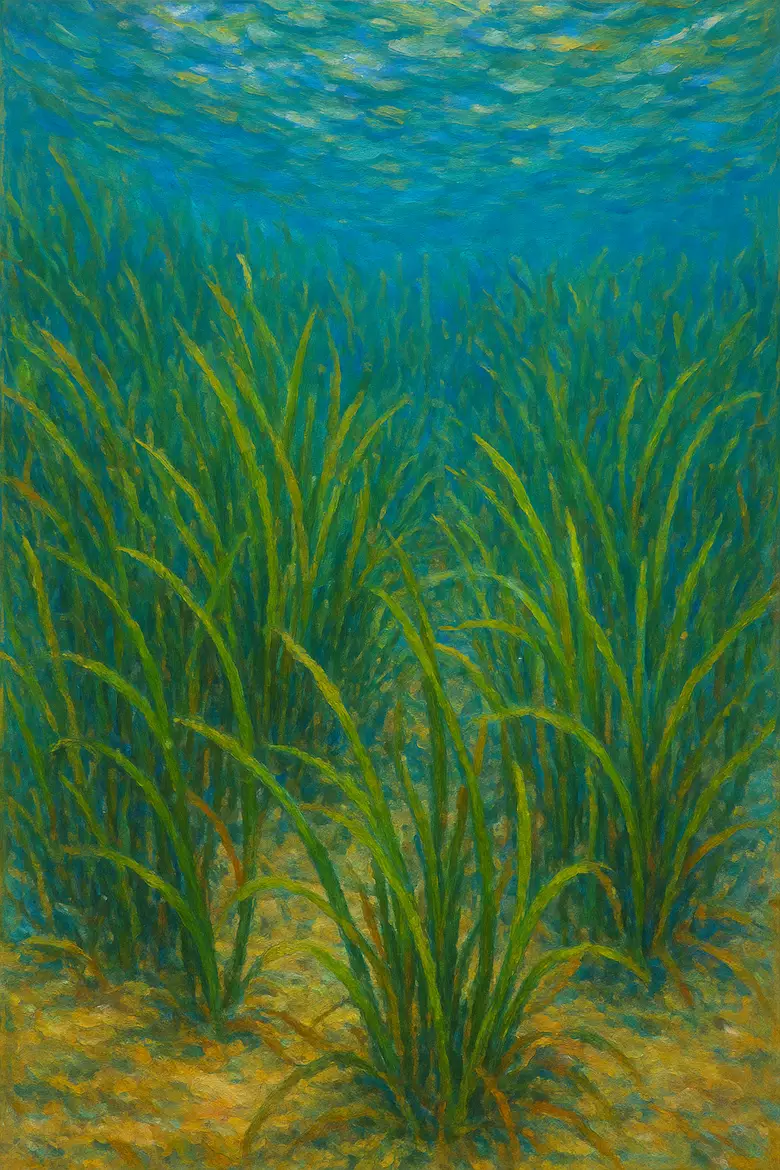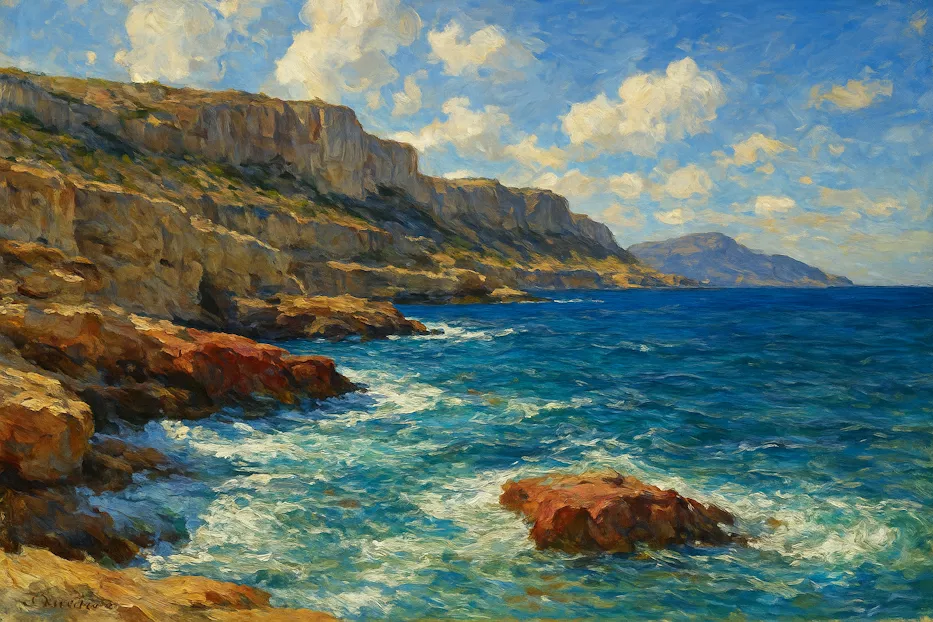Favignana Island is a place where time seems to slow down, offering the perfect escape into the relaxed rhythm of island life.
The ferry from Trapani glides across a sheet of turquoise so clear it seems almost unreal. Within half an hour, the limestone shape of Favignana Island rises on the horizon — pale, flat, and spread like the wings of a butterfly at rest. As the boat docks, pastel houses and fishing boats shimmer in the sun, and the island’s unhurried rhythm begins to unfold.
Favignana is the largest of the Egadi Islands, a small archipelago floating just off Sicily‘s western tip. For centuries, it has been known as the isola del vento — the island of wind. But beyond the breeze that shapes its cliffs and moves through its streets, Favignana carries the calm heartbeat of a place balanced between memory and sea.
Table of Contents
An Island Built by Tuna and Stone
Two forces once defined Favignana’s destiny: tuna and tuff. Both industries left their marks on the land and in its people’s stories.
The Tonnara di Favignana, built in 1859 by the Florio family, stands as a grand relic of a bygone age of industry and salt air. Once one of the largest tuna-processing plants in the Mediterranean, it was the centre of the annual mattanza — the dramatic ritual in which fishermen trapped and hauled giant bluefin tuna in complex nets. The catch sustained generations of islanders and made the Florios one of Sicily’s wealthiest dynasties.
Today, the tonnara is a museum, its vast stone halls filled with nets, anchors, and sepia photographs. The smell of salt still lingers, and the old iron hooks and wooden beams seem to hum with memory. Visitors wander among the displays, listening to recordings of fishermen’s chants that once marked the rhythm of their labor and the heartbeat of the island itself.
The other trade, quarrying, shaped Favignana’s very landscape. For centuries, workers cut into the island’s soft calcarenite stone, carving deep, geometric pits that now resemble open-air cathedrals. Many of these quarries have been abandoned, slowly reclaimed by nature. In one, known as the Giardino dell’Impossibile — the Garden of the Impossible — fig trees, prickly pear, and wildflowers grow in a labyrinth of golden rock and shadow. The contrast between human effort and natural rebirth feels almost sacred.

The Sea in Every Shade of Blue
If the Florios gave Favignana its architecture, the sea gave it its soul.
Nowhere captures that better than Cala Rossa, the island’s most famous cove. Red-tinged cliffs drop into water so luminous it looks lit from within. Legend says the name, “Red Cove,” comes from the blood spilled during a Punic War battle fought along these shores. Today, only the rust-colored stone remembers, and the water glows with layers of turquoise and indigo.
Further south, Cala Azzurra reveals a softer scene: shallow, transparent water lapping against pale sand. Locals favor Lido Burrone, where families gather under umbrellas and the air carries the scent of sunscreen and salt.
Beneath the surface lies another world. Favignana sits within the Egadi Islands Marine Protected Area, the largest marine reserve in the Mediterranean, stretching across nearly 54,000 hectares. Its seabeds are alive with Posidonia oceanica, a flowering seagrass that purifies the water and shelters marine life. Divers explore underwater caves where shafts of sunlight shimmer through, while snorkelers drift above coral gardens, surrounded by shoals of fish and flashes of color that seem to defy the spectrum.

An Island Made for Bicycles
Favignana is small enough to explore on two wheels — and that’s how most visitors choose to do it. The island’s flat terrain makes cycling ideal, with coastal roads looping past cliffs, coves, and olive groves. Along these paths, the sea is almost always in sight, shifting constantly from turquoise to sapphire to emerald.
The eastern side is calm and open, dotted with small farms and wind-bent trees. To the west, Monte Santa Caterina rises above the landscape, crowned by an old fortress built for watchmen and saints alike. From its summit, views stretch across the entire Egadi archipelago: Marettimo lies hazy and distant on the horizon, while Levanzo seems close enough to touch. On clear days, the Sicilian mainland gleams across the water like another world.
Every corner of Favignana feels reachable — not just physically, but emotionally. The absence of traffic and the hum of bicycle chains lend a serenity rarely found elsewhere in the Mediterranean.
Life Around the Harbour
Favignana’s main village gathers around its harbor, where the rhythm of daily life unfolds like an unbroken tradition. Fishermen return at dawn, their boats heavy with silver fish and their laughter carrying over the water. By midmorning, the air fills with the aroma of espresso and fresh pastries from the cafés lining Piazza Europa and Piazza Madrice, shaded by palms and vines.
The pace of the island slows as the sun climbs. Shops close for riposo, shutters drawn against the heat. Evenings revive the streets with a soft glow — scooters buzz, families stroll along the promenade, and the scent of grilled fish and oregano drifts through the alleys.
Favignana’s cuisine celebrates simplicity and sea. Tuna remains its emblem: marinated, grilled, or preserved in olive oil according to ancient methods. Restaurants like SottoSale reinterpret these traditions with elegance, serving tuna tartare alongside pasta with sea urchin or swordfish carpaccio. Elsewhere, humble trattorias offer busiate al pesto trapanese — a local twist on pasta made with almonds, basil, and tomato — and homemade granita to finish.
The Wind That Names the Island
Favignana’s name is said to derive from the Favonio — the west wind that sweeps across the island year-round. It carries salt from the sea, cools the limestone cliffs, and perfumes the air with wild herbs. The wind has become part of the island’s character, shaping its moods and its myths alike.
Yet even as Favignana embraces modern tourism, it remains conscious of its fragility. In summer, ferries bring hundreds of visitors each day, crowding beaches that were once deserted. Locals worry about sustainability — about preserving the delicate ecosystems of the marine reserve, protecting the water supply, and keeping alive the quiet soul that defines the island.
Community initiatives now promote eco-tourism, cycling over cars, and guided tours that teach visitors about the tonnara’s heritage and the marine biodiversity beneath the waves. It’s a model that blends preservation with pride — a rare balance between economy and ecology.
An Island Between Memory and Light
Every stone, every ripple of Favignana tells a story. The quarries whisper of endurance; the tonnara speaks of collective labor and the passage of time. The water, so transparent it mirrors the sky, holds the reflections of all who have crossed it.
Even at its busiest, Favignana manages to preserve a sense of silence — not emptiness, but presence. The kind that settles in the late afternoon, when the wind softens and the limestone glows honey-gold. Then, the island feels suspended between sea and sky, timeless yet fleeting, like a held breath.
Getting There — and Staying Still
Favignana lies just 30 minutes by hydrofoil from Trapani, with regular departures operated by Liberty Lines. Ferries also connect from Marsala, a slightly longer but scenic route. The island can be visited as a day trip, but most travellers stay several nights to feel its rhythm.
Accommodation ranges from small guesthouses in the village to converted farmhouses and boutique hotels among the fields. Popular options include Il Baglio delle Cave, surrounded by quarries, and Casa Margherita, a restored stone villa with views of the sea.
Outside the high season — especially in May, June, or September — Favignana reveals its true self: quiet, radiant, and unhurried. The wind moves through the olive trees, fishermen mend their nets in silence, and the island seems to exhale.
A Lasting Whisper
Favignana is not a destination that dazzles with monuments or luxury. Its beauty lies in balance — between human craft and natural rhythm, between stone and sea, between memory and renewal.
Visitors often leave speaking of its colors: the impossible blues of its coves, the honeyed light of its quarries, the soft white of its village walls. But what lingers longest is the feeling — a sense of serenity that cannot be photographed, only carried home in the mind.
This is Favignana: the butterfly of the Egadi Islands, the island of wind and whispers, where time doesn’t stop — it simply slows enough to be felt.

